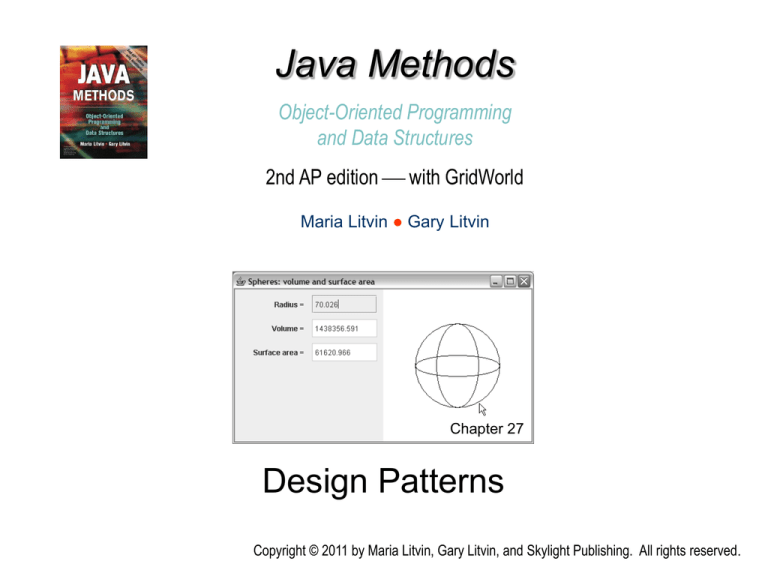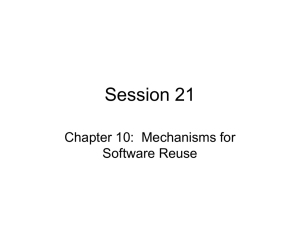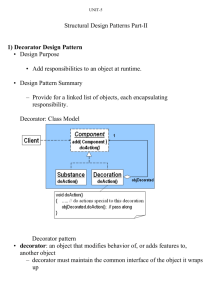
Java Methods
Object-Oriented Programming
and Data Structures
2nd AP edition with GridWorld
Maria Litvin ● Gary Litvin
Chapter 27
Design Patterns
Copyright © 2011 by Maria Litvin, Gary Litvin, and Skylight Publishing. All rights reserved.
Objectives:
• Explore the concept of design pattern
• Get familiar with six introductory design
patterns:
Façade
Strategy
Singleton
Decorator
Composite
MVC (Model-View-Controller)
27-2
Design Patterns
• Design patterns aim to provide ideas and
recipes for sound OO software design.
• The origin of the idea can be traced to some
influential books on architecture by
Christopher Alexander (for example, The
Timeless Way of Building, 1979).
• Hundreds of OO design patterns have been
published since 1995 in books, web sites, etc.
27-3
Design Patterns (cont’d)
• A typical description of a design pattern
includes:
name
brief statement of purpose
description
the types of classes and objects involved
structural diagram
example(s)
27-4
Façade Design Pattern
• Serves to facilitate the use of a complicated
subsystem or package of classes
• Replaces multiple complex interfaces to
several classes with one simplified interface
to the whole subsystem
EasySound
27-5
Façade (cont’d)
• Can be used to encapsulate a process that
involves several steps. For example:
...
Rectangle ocrArea = new Rectangle(200, 20, 120, 30);
ImageEditor imageEditor = new ImageEditor();
String
= OCR.read(image, ocrArea);
imageresult
= imageEditor.cut(image,
TextLocator locator = new TextLocator();
ocrArea = locator.findTextField(image);
String charSet = "0123456789";
OCRReader reader = new OCRReader(charSet);
String result = reader.ocr(image, ocrArea);
...
27-6
Strategy Design Pattern
• If an object (“Player”) may use different
strategies to accomplish a task, make the
strategy module pluggable:
Pass a “Strategy” object to Player’s constructor or
method as a parameter.
The Strategy object “knows” how to accomplish
the task in a particular way.
The Strategy object may also “know” how to adjust
the strategy if necessary or pass a strategy object
of a different type to Player.
27-7
Strategy
(cont’d)
public class Player
{
private Strategy myStrategy;
public Player (... , Strategy s)
{
...
myStrategy = s;
}
public interface Strategy
{
void doSomething (...);
}
public void
setStrategy (Strategy s)
{ myStrategy = s; }
public class StrategyOne
public
class StrategyTwo
implements
Strategy
implements Strategy
{
{
public
void
public
void doSomething
(...)
doSomething(...)
{...}
} { < code > }
}
public void
performTask (...)
{
myStrategy.doSomething (...);
}
...
}
27-8
Singleton Design Pattern
• Is used when the same object must be
accessible in several classes.
• A separate class holds a static variable that
refers to the singleton.
• A static accessor method is provided for the
singleton.
• The singleton is initialized only on the first call
to the accessor.
27-9
Singleton — Example 1
public class SchoolLogo
{
private static ImageIcon logo = null;
public static ImageIcon get ( )
{
if (logo == null)
logo = new ImageIcon ("eagles.jpg");
return logo;
public class School
{
public static void
main (String [ ] args)
{
ImageIcon logo =
SchoolLogo.get ( );
}
}
}
27-10
Singleton — Example 2
public class RandNumGenerator
{
private static Random theRandNumGenerator =
new Random( );
public static Random getInstance ( )
{
return theRandNumGenerator;
}
}
public class Fish
{
...
Random gen = RandNumGenerator.getInstance ( );
...
}
27-11
Decorator Design Pattern
• Solves two problems:
Helps add the same functionality to classes
on diverging inheritance paths
Letter
Certified
LtrWithRetReceipt
Helps add or modify
functionality of an
object at run time
Registered
LtrWithRetReceipt
Circle cir =
new Circle (x0, y0, radius);
cir.draw ();
cir.move (x, y);
DottedLineCircle cirDL =
new DottedLineCircle (cir);
cirDL.draw ();
27-12
Decorator (cont’d)
• The Decorator class
(a.k.a. wrapper class)
extends the decorated
class.
Letter
• A Decorator (wrapper)
object also embeds the
decorated (wrapped)
object.
LtrWithRetReceipt
27-13
Decorator (cont’d)
• Decorator class’s constructor takes a
wrapped object as a parameter:
public class LtrWithRetReceipt extends Letter
{
private Letter myLetter;
public LtrWithRetReceipt (Letter ltr)
{
myLetter = ltr;
}
...
}
27-14
Decorator (cont’d)
• The decorator object passes method calls to
the “decoratee”; can modify some of the
methods:
public class LtrWithRetReceipt extends Letter
{
private Letter myLetter;
private static final double retReceiptFee = 2.25;
...
public double getWeight ( ) { return myLetter.getWeight ( ) ; }
public double getCost ( )
{ return myLetter.getCost ( ) + retReceiptFee; }
...
}
27-15
Decorator (cont’d)
• Decorator design is a kind of do-it-yourself
run-time inheritance.
public class PostageCalculator
{
public static void main (String [ ] args)
{
...
Letter ltr1 = new Letter (weight, destZip);
Letter ltr2 = new LtrWithRetReceipt (ltr1);
System.out.println ( " Cost: " + ltr1.getCost () +
" With return receipt: " + ltr2.getCost ());
}
}
27-16
Decorator (cont’d)
• The java.io package relies extensively on the
Decorator design pattern:
...
myInputFile =
new BufferedReader (new FileReader (fileName), bufferSize);
27-17
Composite Design Pattern
• Is used to represent recursive (nested)
structures
• Applies when a list or a set of objects of a
certain type is also an object of that type
Example 1: Text is a composite for Message
objects; a Text object is also a Message.
Example 2: A LinkedList<Object> is a composite
for Objects because a LinkedList is an Object.
27-18
Composite (cont’d)
Message
• The composite class
extends the “simple”
class.
• A Composite object
also embeds a list or
a set of “simple” or
composite objects.
Text
public class Text extends Message
{
private List<Message> messages;
// Holds Message or Text objects
public void add (Message m)
{ messages.add(m); }
...
public void toString ( )
{ return messages.toString ( ); }
Relies on
polymorphism
}
27-19
Composite (cont’d)
• Another version: both “simple” and
“composite” classes implement the same
interface
«Interface»
Drawable
SimpleStroke
Drawing
27-20
public interface Drawable
{
void draw (Graphics g);
}
public class SimpleStroke
implements Drawable
{
...
public void draw (Graphics g)
{
g.drawLine (x1, y1, x2, y2);
}
}
pic can be a
SimpleStroke or
a Drawing
Composite
(cont’d)
public class Drawing
implements Drawable
{
private Drawable [ ] pics;
...
public void draw (Graphics g)
{
for (Drawable pic : pics)
pic.draw (g);
}
}
27-21
Model-View-Controller (MVC)
Design Pattern
• Is used to support different concurrent or
optional views of a changing “model.”
• The model is an object that represents a
system, a situation, a mathematical object.
• The views are automatically updated when
the model changes.
• It is easy to attach different views to the same
model.
27-22
MVC (cont’d)
• “Totalitarian” design
Controller1
Controller
View1
• MVC design
Controller2
Model
Model
View2
View3
View1
View2
View3
When the model’s state changes,
the model updates all the views
attached to it
27-23
MVC (cont’d)
• The model class extends java.util.Observable,
which provides addObserver, setChanged,
and notifyObservers methods:
public class Sphere extends java.util.Observable
{
...
public void setRadius (double r)
{
myRadius = r;
setChanged ( );
notifyObservers ( );
}
...
}
27-24
MVC (cont’d)
• A view class implements java.util.Observer by
providing an update method:
public class TextView implements java.util.Observer
{
... public class GraphicsView implements java.util.Observer
public
{ void update (Observable model, Object arg)
{
...
Sphere
s = void
(Sphere)
model;
public
update
(Observable model, Object arg)
... {
...
Sphere s = (Sphere) model;
double r = s.getRadius ( );
...
}
}
27-25
MVC (cont’d)
• main (or another constructor or method) can
attach one or more views to the model:
public class MVCSphereDemo
{
public static void main (String [ ] args)
{
Sphere sphere = new Sphere (100);
sphere.addObserver (new TextView ( ));
sphere.addObserver (new GraphicsView ( ));
...
}
...
}
27-26
Science or Art?
OO design patterns and tools
represent a bold attempt to turn the
art of software design into something
more precise, scientific, and
teachable. But, behind all the
technical terms and fancy diagrams,
some art remains an essential
ingredient.
27-27
Quality without a name...
Something — not only the need to
finish a project on time — compels a
designer to look for what Christopher
Alexander called “the quality without
a name”: order, balance, economy, fit
to the purpose, and, in Alexander’s
words, “a subtle kind of freedom from
inner contradictions.”
27-28
Review:
•
•
•
•
What is the purpose of design patterns?
Describe briefly the Façade design pattern.
When do we use Singleton?
Come up with an example where the Strategy
design pattern is called for.
• Name a library package where Strategy is
used.
27-29
Review (cont’d):
• Describe briefly the Decorator design pattern.
• Name a library package where Decorator is
used.
• What is the purpose of the Composite design
pattern?
• Come up with an example where the
Composite design pattern is appropriate.
27-30
Review (cont’d):
• What is the main idea of the Model-ViewController design pattern?
• Name the Java library tools (classes,
interfaces, methods) that support MVC.
27-31










